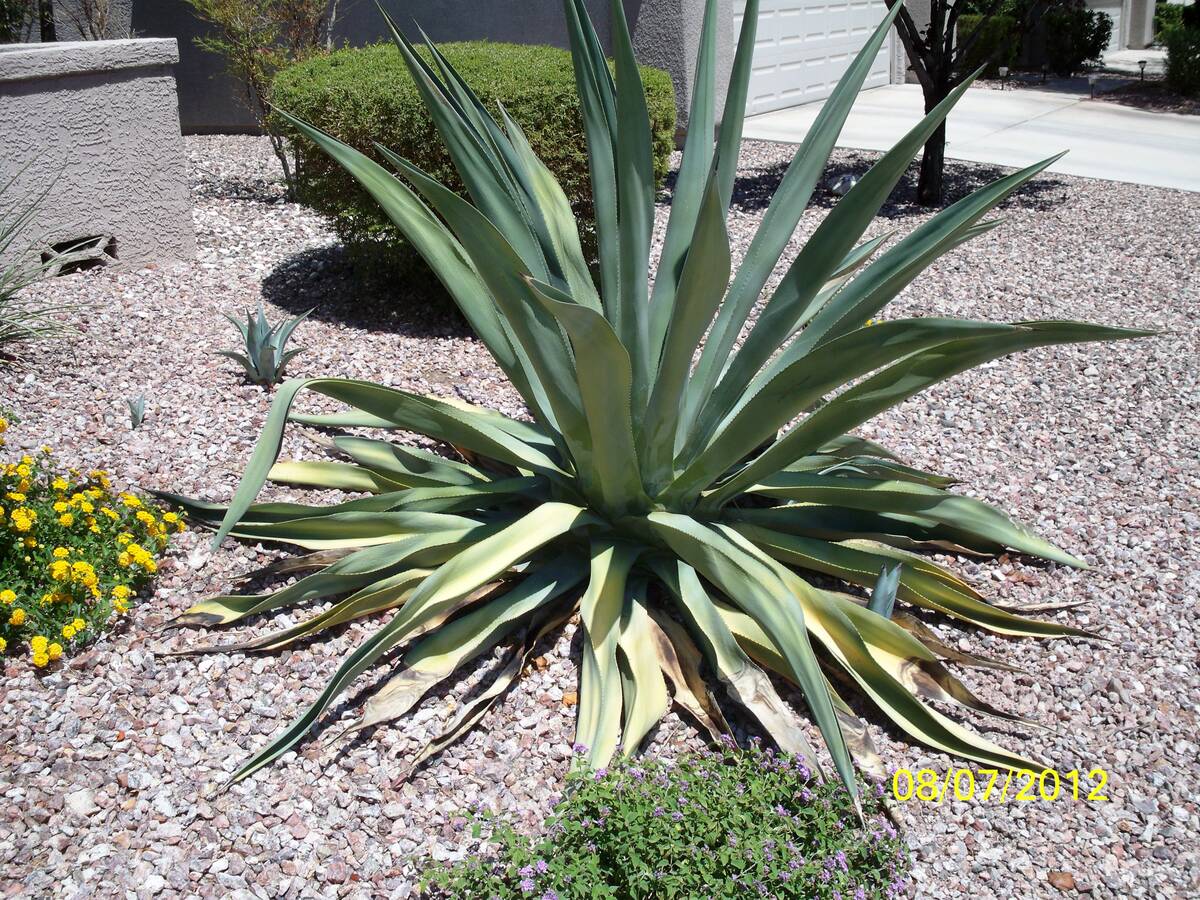Weevil damage to agaves starts in May
Q: When do agave weevils turn into grubs so I can time the treatment to the soil with a pesticide at the correct time?
A: Agave weevil control is done from about the middle of April until the middle of May. The agave weevil adult lays its eggs at the base of agave leaves in about mid-March. These eggs turn into grubs that tunnel inside the stem and start feeding on the plant about the middle of April, depending on the weather. Damage to agaves is starts about May 1, again depending on the temperature.
The usual control method is to nuke them with a soil drench of an insecticide close to the plant. The insecticide is washed into the soil where the roots of the plant are located and not any deeper.
The insecticides used include Sevin, Diazinon and Imidacloprid. Imidacloprid seems to be the most effective of the group.
Because of the threat of these insecticides to honeybees, it’s best to apply them after the plant flowers. Otherwise cut off the flower stalk after the insecticide has been applied.
Insecticides such as neem oil and soap and water sprays are thought to be not as effective. The truth is we don’t know.
If you want to experiment with these, apply them to a large number of agave and see if they work. Otherwise, apply traditional insecticides to be sure. The monthly timing is very important to follow.
The agave weevil flies between agaves looking for the right kind. The right kind of agave has broad leaves such as the American agave and other broadleaved forms. There have been some reports that some yucca plants were also damaged, so you might consider treating both yucca and agave.
Q: I want to put up some shade cloth. What percentage of shade does our valley require?
A: It depends on how you are using shade cloth. If you are using shade cloth above vegetables that flower and produce fruits (tomatoes, eggplant, peppers, squash, melons and cucumbers) then I would use shade cloth that produces about 30 percent shade.
Vegetables that flower and fruit are not usually protected with shade cloth unless there’s a problem that needs to be addressed. As an example, okra will not produce any fruit even with the smallest amount of shade. It’s a beautiful plant at 30 percent shade, but it doesn’t produce any fruit.
Most flowering/fruiting plants need just enough light to produce fruit from their flowers. The more sunlight, the more fruit produced. Too much shade shuts down flowering.
If you are growing leafy greens such as lettuce, spinach, arugula and basil, then you could use 40 percent to 50 percent shade cloth. Intense desert sunlight produces thicker leaves that can be tougher to chew.
That’s undesirable when it comes to leafy greens but not for the flowering/fruiting types. The higher percentage of shade makes the leaves wider and thinner but more easily damaged by wind.
Use windscreens or windbreaks when growing leafy greens with 50 percent shade. Wind barriers help leafy greens from becoming ratty and torn by the wind. Most of these plants (lettuce, spinach, arugula, mustards and other greens) don’t need as much sun as flowering plants but they still need sunlight for production.
If you are sitting under the shade and drinking lemonade, I like 100 percent shade, but that much shade is lousy for producing vegetables and leafy greens. If you are growing vegetables in a raised bed that gets sun all day long, don’t use more than about 30 percent shade cloth. When growing leafy greens, you can bump it up to 50 percent shade cloth but use a windbreak.
Q: My bougainvillea was spectacular last year, and I was expecting growth from the bare branches this spring. The only new growth that my planting has is coming from the bottom. Am I missing something?
A: Bougainvillea, like tomatoes, will freeze and die with the lightest frost. Unlike tomatoes, bougainvillea springs back to life if the top dies to the ground by producing root and basal suckers. Unlike tomatoes, when the top dies bougainvillea can grow from the roots or its base if they are not frozen as well.
Freezing of the soil doesn’t happen in our climate because we have relatively warm winters compared to lower latitudes such as Minnesota.
Cold parts of the valley vary with elevation and location. Generally speaking, the east side of the Las Vegas valley is warmer than the west side. Also, it tends to get cooler as we rise in elevation from the 2,000- to the 3,000-foot level. It usually gets coldest more often in the lowest parts of the valley, such as areas near the Las Vegas Wash, where the cold air settles and slowly drains toward Lake Mead.
Then there’s the impact of wind and landscape microclimates. Climates and microclimates are very complicated.
Bougainvillea and tomatoes are both tropical in their temperature requirements. The soil or earth, particularly when wet, is a great insulator and protects plants below a light frost. After frost, the top of the plant dies and suckers can grow from the roots or the base of the plants depending on their genetics and how cold it gets.
If your plant was lucky enough to sail through nonfreezing weather (which we sometimes get) then it would continue to grow from the branches above ground.
Q: We are having our landscaping done professionally with a 1-inch decorative rock covering just about everything. I seem to remember reading somewhere that the roots of newly planted plants need oxygen and you should not cover the area underneath the plant with the rock. True?
A: That’s not true. Rock provides a very good surface mulch for those plants that can tolerate it. Plants that can tolerate it are oftentimes native plants from the desert Southwest. There are a few other plants that can handle rock mulch as well, but they are also from deserts or at least arid parts of the world.
The basic problem with rock covering the surface is from those plants that are not native to our desert Southwest such as photinia, Japanese blueberry, mock orange and many others that can still handle the heat but not the rock. As the soil loses the organic amendments and its fluffiness provided at planting time, they start to develop growth problems, usually in three to five years.
Generally speaking, plants from our desert Southwest can handle rock landscapes. Plants from other parts of the world cannot or are questionable at best.
Q: I have dogs that dig up my drip irrigation after it’s been installed. Any other possibilities?
A: I don’t know if it’s the sound of the water being applied to these trees or whether they see it or why they are attracted to drip emitters, but try switching your applications to the middle of the night before you change your irrigation system.
Another form of irrigation that may be effective when dogs dig up polyethylene drip lines is called bubbler and basin irrigation. Bubbler and basin irrigation relies on flooding water into a level basin surrounding the plant.
Level basins are about 2 to 3 inches high. These basins effectively are level moats or donuts surrounding the plant. As the plant gets larger, the basin diameter is increased. Increasing the size of the moat applies water over a larger area as the plant grows.
Bubblers, unlike drip emitters, release water quickly and range from half a gallon to 2 gallons per minute. They are spaced about 5 feet apart, so a 10-foot diameter basin would require two bubblers. A 5-foot-diameter basin requires only one bubbler.
This form of irrigation is older than drip irrigation, but it can be nearly as efficient as drip irrigation. The area under trees or shrubs is quickly flooded with water. The soil in the basin is level and the walls of the moat are repaired when they don’t hold water. But the soil outside the basin can be sloped.
The flooding occurs in a matter of minutes and is measured in gallons per minute rather than gallons per hour as drip irrigation.
Bob Morris is a horticulture expert and professor emeritus of the University of Nevada, Las Vegas. Visit his blog at xtremehorticulture.blogspot.com. Send questions to Extremehort@aol.com.























